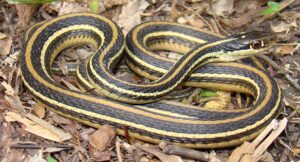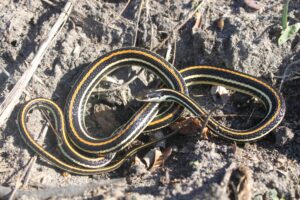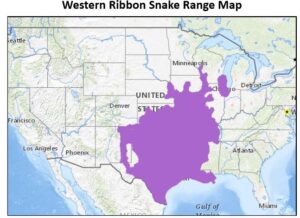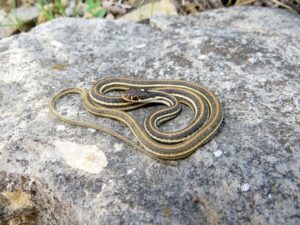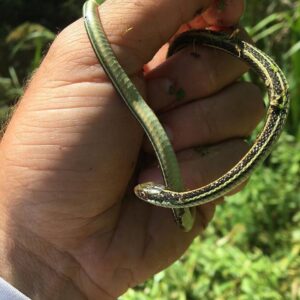The western ribbon snake is a slender, semi-aquatic, medium-sized species of garter snake endemic to Mexico, the western United States, and Central America. It is active at dawn and dusk during spring and fall. But it can be entirely nocturnal in hot habitats during summer. The quick, wary snake swims and climbs readily.
Scientific Classifications
- Suborder:Serpentes
- Family:Colubridae
- Genus:Thamnophis
- Species:T. proximus
Conservation Status
Subspecies
This snake has six recognized subspecies.
- Chiapas Highlands ribbon snake (Thamnophis proximus alpinus)
- Arid land ribbon snake (Thamnophis proximus diabolicus)
- Gulf Coast ribbon snake (Thamnophis proximus orarius)
- Western ribbon snake (Thamnophis proximus proximus)
- Redstripe ribbon snake (Thamnophis proximus rubrilineatus)
- Mexican ribbon snake (Thamnophis proximus rutiloris)
Description
Size
The snake’s total length, including the tail, is 17-50 in (43-127 cm). The colubrid has a very long tail, nearly one-third of the total length of its body.
Color and Appearance
Dorsally, the snake is brown, blackish, or olive with three light-colored stripes. It has a greenish-white or yellowish-white venter. The upper labials are unmarked and whitish which is in contrast to the dark top and sides of the head.
It has keeled scales, round pupils, and the head wider than the long, slender neck. Though not sexually dimorphic, the females of this species are generally thicker than the males.
Are They Dangerous to Humans
Though non-venomous, its saliva has been reported to have toxic properties. But very few envenomations have been reported; hence, they are not considered dangerous to humans. When captured, it thrashes around its tail in a bid to escape, usually secreting a foul musk or spraying its feces to encourage its enemy to let it go. It can also shed its tail that continues to move, allowing the snake to escape. It doesn’t bite unless provoked.
Western Ribbon Snakes at a Glance
Distribution
It can be found in many parts of the south-central United States, throughout Mexico, along the Atlantic versant, as far as Costa Rica.
Habitat
The snakes live in brush-heavy habitats, close to sources of water like ponds, streams, lakes, etc. They can be seen basking on flat vegetation or rocks or in drier, sandy areas close to water.
Lifespan
The western ribbon snake lives for 3 to 6 years.
Predators
Various animals prey on the snake. These include ferrets, weasels, large fish, eagles, hawks, falcons, baby turtles, and larger snakes like cottonmouths, milksnakes, and rattlesnakes.
Diet
Its diet includes toads, frogs, tadpoles, lizards, salamanders, and fish.
Reproduction
Ovoviviparous (gives birth to live young from eggs that hatch inside the body)
The females are gravid from April but give birth only between June and mid-September. 3-21 offspring make up a litter. Their average length is 16-28 cm.
Similar Species
The common garter snake (Thamnophis sirtalis) has lateral stripes on the second and third scale rows, while the western ribbon snake has similar stripes on the third and fourth scale rows. Plus, the former has a shorter tail. There are also black bars on the posterior labial scales of the common garter snake, while the same are unmarked in the western ribbon snake.
Source
illinois.gov, iowaherps.com, birdwatchinghq.com, iowaherps.com, i.pinimg.com

